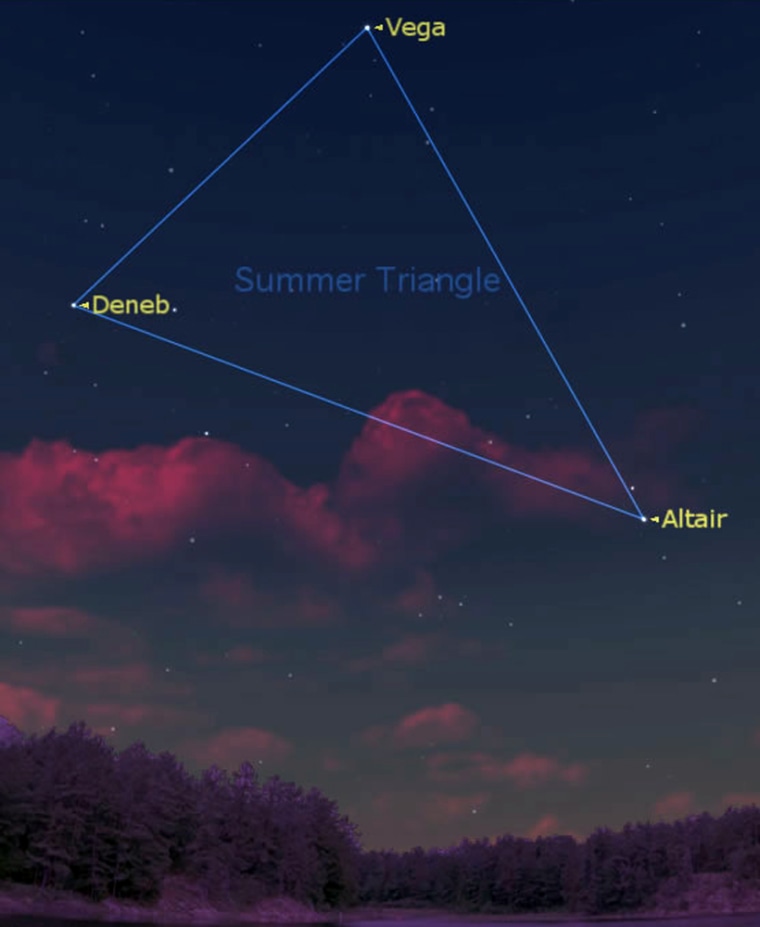Well up in the eastern sky during the late-evening hours is the "Summer Triangle," not a constellation, but a very noteworthy star pattern of the summer sky consisting of three bright stars from three constellations.
Brightest of the three is Vega, in the constellation of Lyra, the Lyre. Next in brightness is Altair in Aquila, the Eagle. Finally, there is Deneb in Cygnus, the Swan.
To our eyes, Altair appears to shine only half as bright as Vega and Deneb seems only one-third as bright as Vega. So at first glance, Vega appears to rule this section of the sky. In reality, however, a bit of celestial deception is at work here, for Vega is appears very bright chiefly because of its proximity to us. Vega is 25 light-years away, so when you are looking at it tonight, you are really seeing it as it was back in 1982.
Altair is 17 light-years away, closer than Vega, yet appearing somewhat dimmer. That tells us that in terms of overall luminosity between the two, Vega is indeed the brighter star: it is 48 times brighter than our sun, while Altair is only 12 times brighter.
A true giant
But what about the third star in the triangle, Deneb? Here, there is no comparison between either Altair or even Vega, for Deneb is one of the greatest supergiant stars known. It shines about 80,000 times brighter than our sun, but because of its vast distance from us — 1,467 light-years away — it appears as just a fairly conspicuous but by no means noteworthy star.
If it were somehow possible to move Deneb to Vega's distance from us, it would then appear to shine 16 times brighter than Venus is now, and capable of casting distinct shadows and be visible even in the daytime. Conversely, if we were to move Vega out to where Deneb is, it would shine only as bright as a ninth-magnitude star; you would need a star atlas to precisely locate it, and it would only be visible in good binoculars or a telescope.
With the bright moon now pretty much out of the evening sky this week, there is no better time than now to observe the beautiful summer Milky Way. With a good pair of binoculars or a telescope you can now observe millions of sparkling little stars that make up this glowing, irregular belt of luminosity. It appears to arch from the north-northeast to the south-southeast, with its brightest and most spectacular region running across the Summer Triangle and beyond toward the south-southeast horizon.
Slideshow 12 photos
Month in Space: January 2014
There appears to be a great black rift (sometimes called the "bifurcation") dividing it into two streams, beginning with Cygnus and extending down toward the south. Also in Cygnus is the black void known as the Northern Coal Sack. This Coal Sack and the Rift are not holes in the Milky Way, but rather are vast clouds of dust drifting in interstellar space which, from our Earthly perspective, presents a solid and impenetrable curtain between us and the more distant stars.
Stuff of legends
There have been many stories, myths and legends told about the Milky Way in many different cultures.
This particular weekend, the Milky Way involves a poignant Japanese legend. The star Vega represented Orihime, who produced brilliantly colored fabrics. Across the "Heavenly River" (the Milky Way), Altair represented the cowherd Kengyu. After meeting each other they received divine permission to marry, whereupon both abandoned their occupations. This angered the gods who separated them and sent them back to their original jobs on opposite sides of the heavenly river. The couple however, received permission from the gods to get together for one night each year.
That special night is July 7 — but only if the sky is clear!
As a result, the evening of July 7 has evolved into a young-people's holiday in Japan called Tanabata. Prayers are then offered for clear skies so that Orihime and Kengyu, the star-crossed lovers can be reunited. One popular Tanabata custom is to write one's wishes on a piece of paper, and hang that piece of paper on a specially erected bamboo tree, in the hope that the wishes come true.

